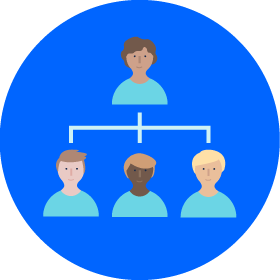Atlassian’s best practices for leading effective enterprises
Shift your mindset to focus on outcomes, long-term goals, and customer relevancy.
As management guru Peter Drucker famously said: “Efficiency is doing things right; effectiveness is doing the right things.” Drucker also said: “Management is doing things right; leadership is doing the right things.”
While both efficiency and effectiveness are important, without effectiveness, there is no performance. Far too often, enterprises organizations fall into the efficiency trap, over-indexing on speed and tools. The concept of speed to market, and delivering more and faster, can be blinding, and organizations tend to focus on near-sided outputs rather than outcomes. It doesn’t matter how fast to market you are or how many releases you have if you’re not delivering the outcomes that customers need or want. In the face of this, leaders must shift their mindset (and their organizations) to focus on outcomes, long-term goals, and customer relevancy.
We know this is easier said than done. Most large-scale enterprises, regulated industries, and government agencies operate like multiple businesses within one. These disparate entities may be leveraging different ways of working, using different tools, and even pursuing different goals, all of which increase the complexity of doing just about anything, creating a barrier to effectiveness.
So how, as a leader, do you improve effectiveness – in other words, do the “right things” – under these circumstances? To evolve the way an organization works, turn to practices, not processes, that can be adopted across the company. The difference between the two is critical: practices are not top-down initiatives forcing a process, nor do they call for complete standardization (this reflects an efficiency mindset). Rather, practices serve as a helping hand to guide teams and establish a common framework, while also providing the flexibility and freedom to get sh*! done.
Developing best practices
Several years ago, Atlassian recognized we were running into some of the issues described above. We were trying to bring multiple products to market with a variety of teams and a globally distributed workforce. In order to continue delivering high-volume, high-quality services and products, we needed to shift the way our teams were working together and ensure they focused on long-term goals rather than individual output. From a combination of our own experience, and in-depth research and conversations with customers, the Atlassian Team Playbook was born. Plays (our nomenclature for the way we implement best practices) remove the naturally occurring friction that prevents teams from being effective. Their execution is flexible, so teams are free to put their own spin on them. They provide a common language used across the entire company, allowing teams to spend their mental energy on outcomes rather than spinning up bespoke ways to speed up their tasks. Simply put, running plays makes our teams more effective. While we built this for our own needs, we now share them publicly, free for anyone to use.
Healthy teams are happier and more productive. It pays to invest in the teams, not just the product.
Cliff Obrecht, COO at Canva
Whether you choose to run plays from our Playbook or develop your own set of practices (or a hybrid of the two), the important thing is to establish a shared understanding between individuals and across teams, embrace variability where it’s valuable, and set up your org for long-term success.
Leading teams towards effective behavior
The sheer size and complexity of modern-day enterprises make them ripe for continual change and improvement; they’re constantly addressing new people, new ideas, and new regulations. While all enterprise implementations (e.g., solutions and tooling) are unique, companies with highly fragmented business lines or shifting regulations often have to overcome additional levels of roadblocks and pushback. Focusing on effectiveness and relying on practices is even more pertinent for these kinds of enterprises. Due to their complex nature, leadership must provide a schema and direct teams’ energy in the right direction, remembering that focusing on specific processes or time allocations will not lead to success.
So where can you start shifting your focus towards effectiveness? We suggest looking inward. Ask yourself:
- Are your objectives aligned at an enterprise, organizational, and team level?
- Are your goals built around effectiveness or efficiency?
- Do you base decisions on high impact or speed?
These questions can help you identify opportunities to improve the effectiveness of your organization.
Set clear objectives across an enterprise
Creating clear and visible objectives will help your organization stay effective and drive high-impact results by enabling teams to work on the right things. For large-scale enterprises with multiple business lines or companies that are forced to work in siloed environments, this is even more essential. Far too often, different departments, program and business lines forget they are playing for the same team.
Setting clear objectives at team, department, and organizational levels ensures everyone is clear on what they are working towards. We use OKRs, or Objectives and Key Results, at all three levels, ensuring our work is connected and driving maximum value.
Create a shared understanding of goals
Without a shared understanding, your organization can easily fall into the trap of getting a lot done but producing nothing – so it’s important for teams to find their North Star. This could be customer retention, standing up a new program, or whatever is important to your company or organization. Having a mutual understanding of goals gives your teams a united vision and collective purpose, and in turn the confidence they need to make the right strategic bets to achieve success. These goals ladder up to help teams reach their larger objectives. We utilize the Goals, Signals, and Measures play to ensure that people, teams, and departments are effective in meeting those goals. It’s important to know where you’re headed, define signals so you know you’re on the right path, and identify what measures you’ll use to know when you’ve reached your destination – then, your teams will have the freedom and autonomy to work the way they see fit while staying on track for delivery.
Develop consistent decision making
Work can’t begin, or continue, without a decision being made. This might seem obvious, but decisions – or lack thereof – are one of the biggest threats to both efficiency and effectiveness. In decision-making, you’re battling two enemies: time, which dictates how long until your teams or organization can start working towards outcomes, and quality, which correlates directly to the effectiveness of the outcome. Often, large-scale decisions require participants and input from multiple verticals in a business. Take a common enterprise sales motion or large government program management, for example. For either of these, there are typically eight or nine individuals in the purchase process, in roles ranging from IT to security, to procurement to legal and beyond – that’s a lot of opinions. Bringing structure to these circumstances helps organizations make group decisions efficiently and effectively. We use a DACI framework to define roles for all high-impact or high-risk group decisions.
To find out more about how to build an efficient and effective enterprise using tools and practices, check out the webinar.




